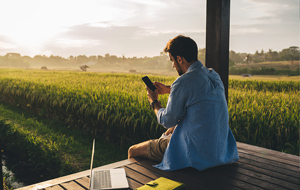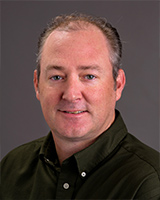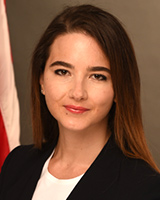Feb 02, 2022
A New Era of Health Literacy? Expanded Definitions, Digital Influences, and Rural Inequities
Related Articles
This is part one of a two-part 2022 Rural Monitor series
on health literacy. Read part two: Educating
Future Healthcare Providers: Health Literacy
Opportunities for Webside Manners.
In 2017, the Rural Monitor also published two rural
health literacy stories: Rural Health
Literacy: Understanding Skills and Demands is Key to
Improvement and Rural
Health Literacy: Who's Delivering Health Information?
 The languages of medicine. First,
there is the jargon-packed peer-to-peer language used by
healthcare providers to discuss patient care. Second
comes an even more elaborate language dedicated to
specialty medical care. A third language exists because
of the MSDRG system, or Medicare Severity Diagnosis
Related Groups. Different from providers' clinical
language, it is a language that belongs to data
collection and billing — but it is also a
language that providers must master.
The languages of medicine. First,
there is the jargon-packed peer-to-peer language used by
healthcare providers to discuss patient care. Second
comes an even more elaborate language dedicated to
specialty medical care. A third language exists because
of the MSDRG system, or Medicare Severity Diagnosis
Related Groups. Different from providers' clinical
language, it is a language that belongs to data
collection and billing — but it is also a
language that providers must master.
Yet there is a fourth language that providers do understand — but don't always speak fluently: the plain language used by their patients.
"Doctors and healthcare professionals are really good at listening to patients speak in plain language when they describe what's going on with their health," Stan Hudson, Wisconsin Health Literacy (WHL) director said. "Think about it: Providers don't need patients to translate that plain language into a medical jargon in order for them to make a specific diagnosis or create a treatment plan."

However, Hudson emphasized that because the reverse is not always true, inequity can result.
"Providers can forget to translate their information back into plain language for their patients," he said. "This lends to the creation of an unequal system of information-sharing in healthcare. Healthcare providers don't always consider that their use of jargon alone can lead to an information divide or inequity. It's important for them to understand that using plain language is important when communicating with the people they serve."
Health Literacy: Skills, Demands, Expanded Definitions
Public health communication experts pointed out that plain language is a key element of health literacy (HL), previously defined as the "degree to which individuals have the capacity to obtain, process, and understand basic health information and services needed to make appropriate health decisions."
In a 2017 Rural Monitor story, HL experts explained that understanding health information has two sides. First is the "skill side," described as a measured proficiency, such as how easy it is to complete a task like searching a medical brochure to find a medical term definition. The second is the "demand side," defined as the "knowledge, skill, and cognitive effort that are part of a health-related task." An example is the comprehension, concentration, and attention needed to fill out a complex form with legal jargon or understand information with complex numbers or instructions that come with lots of words with no pictures."
Dr. Paul Smith, an HL expert interviewed in the 2017 story, pointed out that it's important for healthcare organizations to recognize that potentially all of the patients who seek care can experience health literacy challenges, depending on circumstances:
"Even for the folks who do have [health literacy] proficiency, all you have to do is to give them a cancer diagnosis, make them sleep deprived, experiencing severe pain, any of those things that happen all the time in a hospital or an emergency room," he said. "Anybody, anybody with those things happening is going to have trouble processing, remembering, or making decisions related to healthcare information."
As the medical field advances, its technical and professional language changes. HL experts said this modernization requires patients to advance their ability to access well-vetted and plain language health information. After several years of discussion and public comment, two expanded definitions for HL have also emerged as part of the Office of Disease Prevention and Health Promotion's (ODPHP) Healthy People 2030:
- Personal health literacy: the degree to which individuals have the ability to find, understand, and use information and services to inform health-related decisions and actions for themselves and others.
- Organizational health literacy: the degree to which organizations equitably enable individuals to find, understand, and use information and services to inform health-related decisions and actions for themselves and others.
Of note, for the first time, HL is now a central focus in Healthy People 2030, the ODPHP's fifth iteration of the work.
The HL of Rural Populations
One of the first reports — and still one of the few comprehensive reports — on rural health literacy came from the distillation of data from a dedicated national HL survey. In their 2009 academic paper, the authors said that after adjusting for important variables, there was no significant difference in health literacy between rural and urban populations. Instead, noted variances were "linked to differences in age, gender, race, ethnicity, education, and income," rather than ZIP code.
A recent 2020 global review found that "rurality alone does not explain rural-urban health literacy differences and that sociodemographic factors play important roles." State-level rural insight comes from a recent COVID-centric study looking at HL in rural Arkansas that found that lower HL was not necessarily linked to lower income.
Organizational Health Literacy: What Are the Benefits?
Research has provided evidence around the advantages of organizational health literacy (OHL), and the National Academy of Medicine (NAM) has been at the forefront of OHL work with a 2012 paper focusing on the 10 attributes of OHL. In 2018, NAM sponsored a workshop that focused on the effect of HL interventions on "costs, quality, behaviors, outcomes, and other areas." In their commissioned paper for the event, WHL's Hudson and coauthors provided a financial and ethical HL-linked overview, noting, "Health literacy is not just the right thing to do for the patient. It is also the right thing to do to make sure we control costs and improve quality."
The Agency for Healthcare Quality and Research (AHRQ) Health Literacy Universal Precautions Toolkit includes guidance on increasing OHL, specifically referencing Building Health Literate Organizations: A Guidebook to Achieving Organizational Change. This resource was created by Iowa's Unity Point Health, an organization that serves multiple rural Iowa communities.
Steps to OHL
In a 2018 academic review outlining transformation steps, a Canadian team found that the top 6 barriers to improving health literacy within an organization were:
- Low priority of health literacy and related activities
- Lack of commitment to health literacy
- Limited or no buy-in from leadership
- Perception that becoming health-literate is not advantageous
- Lack of culture of change and innovation
- No change champions in the organization
In a 2021 review, European authors included which implementation steps had a positive impact on operational activities:
- Embedding strategic priorities, frameworks, and policies
- Organization-wide platform to revise health information materials, including website design that's easy to navigate
- Service procedure redesign to improve HL screening and patient engagement
- Staff HL capacity building (communication)
The Digital Influence of Accessing Health Information
Almost every aspect associated with the activities of daily living is experiencing pressure to move to either an online site or a mobile app. Experts said this pressure is taking HL right along with it — resulting in a need for an additional HL definition: digital health literacy (DHL). A 2006 definition of DHL that's commonly cited — and one of three used by the World Health Organization — is "the ability to seek, find, understand, and appraise health information from electronic sources and apply the knowledge gained to addressing or solving a health problem."
DHL Skills
Although HL experts have recognized the role of digital problem solving as related to DHL for more than two decades, nomenclature has been varied, with DHL also referred to as eHealth, mHealth – or, as one expert pointed out, "twenty-five years ago, it was called consumer health informatics."
In highlighting DHL's differences from "other distinct forms of literacy," authors of a 2019 paper distilled a digital HL skill set down to basic reading and writing skills; possessing the ability to use a computer; and "understanding how, why, and when online health information is created, shared, and received."
Experts agreed that although
"digital" is having a tremendous
influence on where health information is parked,
attention to how patients are able to access or process
the information in that digital parking lot is lacking.
Some experts suggested that efforts to create a new
"digital" health literacy playbook
for improving access are slow or even non-existent.
Several Society of Public Health Education leaders
commented in a
2019 paper, "Despite widespread use of the
Internet and social media platforms by the public, there
has been little organized exchange of information among
the academic, government, and technology sectors about
how digital communication technologies can be maximized
to improve public health."
DHL, COVID, and College Students
Providing some insight into DHL consumer skills was a recent study surveying a small number of U.S. college students. Results indicated that a higher digital HL — but not traditional HL — "was significantly associated with greater willingness to get a COVID-19 vaccine and the belief that acquiring the disease would negatively impact their life."

Dr. Cynthia Baur, a member of the Secretary's Advisory Committee on National Health Promotion and Disease Prevention Objectives for 2030's Health Literacy Subgroup and director of the University of Maryland School of Public Health Horowitz Center for Health Literacy, commented on the speed of moving to improving patients' access to digital health information.
"Public health and healthcare organization leaders are the people who are in charge of so much of the available information," she said. "Ultimately this makes them the changemakers for improving health literacy. They're the individuals who'll need to drive the speed of change."
Long recognized as a leader in health literacy, WHL is emerging as a leader in the DHL arena too. Hudson talked about his organization's current work creating a program that helps patients improve their digital access skills.
"Some time ago, we recognized that no one was in the space of helping people find reliable online health information," he said. "If you could use a computer, you might enter a few words into a search engine, next have to try to sift through millions of results, and then try to figure out what was good information. To help folks do the searches and find that trusted information, we developed Health Online: Finding Information You Can Trust, a program funded by the Network of the National Library of Medicine which provides community-based education for just this type of need. It's a program we take into communities. It's been really successful and we now officially partner with the All of Us Community Engagement Network in their efforts to also provide training."
Improving Personal DHL: More about WHL's Health Online Program
With the assistance of grant funding, WHL created their DHL program specifically for underrepresented populations to be able to better access, identify, and use reliable health information from internet searches. Since 2018, WHL has completed over 60 community-based workshops, which served nearly 600 people in urban and rural communities. Fourteen train-the-trainer sessions reaching about 150 librarians have also been completed. More information about the project can be found in the grant's final Phase 1 and Phase 2 reports.
Digital literacy training is also available through Wisconsin Literacy, WHL's parent organization. Hudson also pointed to Literacy Minnesota's work in the digital proficiency space.
Detailing DHL Challenges
Baur provided examples of digital access barriers that could influence research around strategic digital website design planning and user testing.
If they do find their way into the information, they can't always find their way back. Getting stuck in a website causes lots of patient frustration.
"When a patient goes to a website, they don't know the usual organizational website conventions, or how to anticipate a drop-down menu or how to toggle back and forth between information tabs," Baur said. "If they do find their way into the information, they can't always find their way back. Getting stuck in a website causes lots of patient frustration."
Baur also discussed some of her organization's research around accessing digital health information.
"We've found that just because people have smartphones, they're not necessarily smartphone application users," she said. "If they do download apps, they may not be able to use them with proficiency."
Eye on Apps and Health Outcomes
A 2020 paper in Nature found only a "small number of clinical scenarios where published evidence suggests that mHealth apps may improve patient outcomes."
Talking about the digital challenges associated with "patient portals" specifically, Hudson also shared examples of digital barriers. A patient portal refers to "a secure online website that gives patients convenient, 24-hour access to personal health information from anywhere with an Internet connection."
"If you want to ask your doctor a question, anymore it is preferred you use your health portal to get a response," he explained. "Patients have to access their portal, leave a typed message, and then someone in the office will respond, but usually only online in the portal. We are finding that more and more of our community-based session attendees are requesting instruction around their patient portal use."
Hudson also said that the patient portal access looms large for patients because every health system and insurance company customizes their electronic record and website. Every customized label that exists for the same website feature looks different from organization to organization. Specific feature tabs also differ in a location and content that varies from portal to portal and website to website. He said the complexity and confusion grows if a patient's insurance changes, or a patient changes or adds new healthcare providers.
"Additionally, the healthcare industry really doesn't use much user testing prior to any digital access implementation," Hudson said, in contrast to other businesses and organizations.
Broadband Inequity = Health Information Inequity
Experts said it's simple: No broadband, no health information access. Sometimes these limitations translate into a scenario not atypical for rural patients who end up with a face-to-face encounter as the only option for accessing health information. Experts said to consider this: A typical long-distance rural geographic footprint compounded by bad weather? It's hard to justify a three-hour drive in bad weather for a 10-minute face-to-face discussion just to get health information that could have been accessed online.
Baur said that rural health broadband advocates might want to fold these aspects of HL into their efforts to increase rural broadband infrastructure.
"Rural healthcare advocacy is critical for digital services in their communities since these digital connections are necessary for health information access," she said. "The pandemic has really exposed this inequality: If people are not connected to the digital infrastructure, they're left out."
Other HL experts pointed out that rural broadband inequity not only limits access to public health digital information, but to personal digital health information found only in the electronic health record. Rural data looking at the extent of patients' digital access of their health information is sparse. A 2016 data brief from the Office of the National Coordinator (ONC) found that in 2014, 14% of rural respondents had reviewed personal health information results compared to 23%/26% in suburban/urban areas. Another ONC 2021 brief reviewing 2020 smartphone app and patient portal access survey data — a brief that did not include rurality — found that about 40% of those surveyed used their smartphone to access their patient portal. Additionally, 30% had downloaded their medical records, a percentage that had almost doubled since 2017.

Leila Samy is ONC's Chair of the Strategic Management Advisory Committee, a founding member of its committee on diversity, equity, inclusion, and accessibility, and serves as rural health IT coordinator. She said ONC continues to be active in improving equitable access to digital health information for all patients, including those in rural areas. Additionally, ONC has heard that a top challenge for rural providers is the cost to set up and maintain interfaces to exchange data with a varied landscape of exchange partners. ONC's recently announced Trusted Exchange Framework and Common Agreement (TEFCA) will help rural providers by decreasing the administrative burden and costs associated with data exchange. She commented that these efforts, as well as ONC's efforts to guard against information blocking, would have downstream positive impacts on HL.
"Health literacy is an important dimension to increasing patient engagement," she said. "We don't want individuals living in rural communities, including rural tribes, Veterans, and other rural residents, to feel like they are on the outside looking in because of a digital divide."
Digital Decision-Making Health Tools
While the solution to the rural digital divide is awaited, Baur offered that there is a need for continued forward motion on improving the functionality of available digital health information.
"We need to take advantage of what we can't do in the paper world instead of just recreating an online text-heavy brochure," she said. "For example, for those with reading difficulty, a smartphone application could include a click button so the information could be heard instead of read. We also know that people are very attracted to audiovisual content, so we need to question whether we're really doing enough in this space and research best ways to fill any gaps."
Baur also discussed the benefits of interactive digital decision-making support tools: for example, those that provide risk assessments. She noted that although healthcare providers believe these provide valuable information, they need to recognize that their patients still need to understand why the information is valuable. Using the example of the BMI calculator, or body mass index, she emphasized that risk is a very complicated concept.
'At risk' is a phrase we use all the time in public health. If people are at an increased risk, we point out ways they can lower their risk. But that still requires further explanation.
"Although a calculator mitigates low numeracy and graph-reading skills, people still need to know what a body mass index is and how it's a guide to risk if the numbers are high," she shared. "'At risk' is a phrase we use all the time in public health. If people are at an increased risk, we point out ways they can lower their risk. But that still requires further explanation. You can automate certain things in health and still not have sufficient explanation to help people appreciate why they should care about their BMI or their diabetes risk or whatever the risk being discussed."
The Rural Future of Health Literacy
Baur pointed out the importance of future HL/DHL research. Though some experts believe that HL needs can be addressed by using a universal approach — exemplified by the Agency Research and Healthcare Quality's (ARHQ) HL toolkit — she said she believes that looking at specific population needs like those of rural residents are important. For example, asking how healthcare information gets into and circulates in a community provides insights into health information-seeking and studying the number of repeat exposures to information to improve awareness and comprehension might be required as well.
"There's still work to be done to try and understand what, if anything, is different about the kind of health information access and communication is happening in rural communities," she said. "Assumptions are made, but whether those assumptions are true should be evaluated, especially those questions about health communication being different for rural residents."
In summary, Baur and Hudson returned to the basic aspects of HL that they believe are important with regard to rural populations as well as for urban populations.
Health literacy is not actively arguing about what health behavior must be used to stay healthy. That's not going to work with a lot of people.
"Health literacy is not actively arguing about what health behavior must be used to stay healthy," Hudson said. "That's not going to work with a lot of people. It's making sure people have access to well-vetted health information that's easy to understand. That way people make up their own minds."
Baur adds an additional perspective, providing a reminder for healthcare systems with an eye on equity.
"Health literacy is a pretty straightforward idea," she said. "Most people know that understanding what's going on with their health is important. They also understand and have experienced that getting good care and services and information is way more burdensome than it needs to be. However, they're not really sure what to do about it. They feel it's their problem — their lack of knowledge or skill, which leads to their inability to access what they need. However, what they're actually dealing with is a highly impenetrable system."
Strategic Publications & Notable Health Literacy Dates
Centers for Disease Control and Prevention (CDC)
- Health Literacy
- Health Literacy Activities by State
- Specific free training, registration required:
- Health Equity Guiding Principles for Inclusive Communication
Centers for Medicare and Medicaid Services (CMS)
Health Resources and Services Administration (HRSA)
Florida Rural Health Association
Institute for Healthcare Advancement
1975: Health literacy first defined
2000: National Library of Medicine Current Bibliographies in Medicine: Health Literacy
2003: National Center for Education Statistics: First and only health literacy survey
2006: Digital health literacy described in eHealth Literacy: Essential Skills for Consumer Health in a Networked World
2009: Rural health literacy reviewed in Health Literacy Skills in Rural and Urban Populations
2010: Office of Disease Prevention and Health Promotion (ODPHP) National Action Plan to Improve Health Literacy
2016: National Academy of Medicine (NAM) Considerations for a New Definition of Health Literacy
2016: ODPHP: Health Literacy Online for improving online user experience
2018: NAM Building the Case for Health Literacy: Proceedings of a Workshop. The commissioned report, Improving Health and the Bottom Line: The Case for Health Literacy, is available in Appendix C and also discussed in Chapter 3.
2020: NAM Health Literacy and Health Education in Schools: Collaboration for Action
2021: ODPHP Updating Health Literacy for Healthy People 2030



